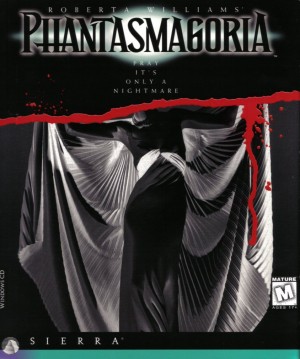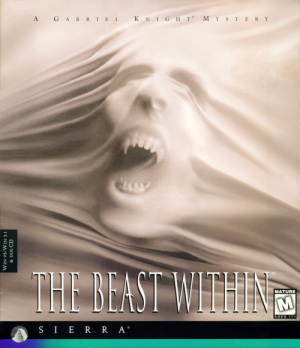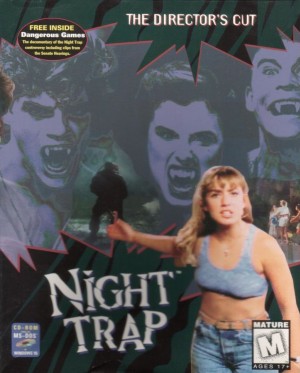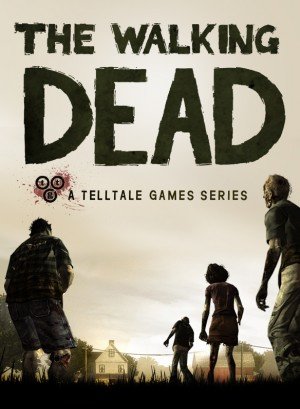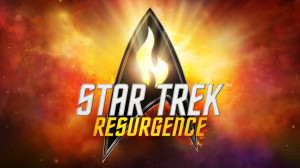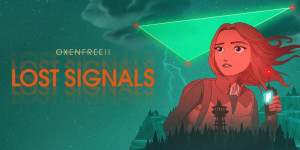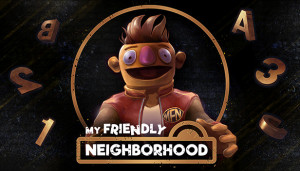An interview with Richard Moss interview
__big.jpg)
Today, we're thrilled to have Richard Moss with us, a distinguished figure in the world of gaming documentaries and literature. Richard is currently working as the writer and director of the upcoming docuseries TerrorBytes: The Evolution of Horror Gaming, a comprehensive exploration of the horror genre in gaming. His contributions to the field extend beyond this series, as he is also known for his roles in acclaimed projects like FPS: First Person Shooter, and for his insightful books such as The Secret History of Mac Gaming and Shareware Heroes. His deep understanding and passion for gaming history bring a unique perspective to the discussion of horror games, a genre that continues to captivate and terrify players worldwide.
The pre-sales campaign for TerrorBytes: The Evolution of Horror Gaming is now live. It's not just a chance to grab exclusive merchandise or secure early access to the series; by participating in the pre-sales, you're playing a pivotal role in bringing this project to life, as every purchase directly contributes to the production and post-production budgets. This means enhanced sound quality, more polished motion graphics, and possibly even additional interviews — all combining to make TerrorBytes something truly extraordinary. Your support could be the key to elevating this series to new heights of engagement and excellence.
And now, without further ado, let's dive into our exclusive interview with the mind behind this thrilling project, Richard Moss, as he shares insights on the making of TerrorBytes and the history of horror gaming.
Adventure Gamers: In TerrorBytes, you delve into the growth of horror gaming, a genre rich with innovation and transformation over the years. Reflecting on your extensive research and interviews for the series, what do you believe have been the key turning points or technological advancements in horror gaming history that have significantly influenced the genre's development?
Richard Moss: I'd say it's been a mix of design and technological innovations that have driven horror's evolution in games. On the technological front, the CD-ROM's arrival in the early 90s was a big deal as it enabled the use of full-motion video — used to particularly great effect as a tool to enhance the horror experience in The 7th Guest, Harvester, and Gabriel Knight 2. It also allowed lots of experimentation with adapting movie horror to games, for better or worse, such as in Phantasmagoria and Night Trap.
Another key technological advancement, which went hand-in-hand with the CD-ROM, was 3D graphics — particularly the PlayStation 1, which had just enough power to provide compelling and detailed 3D environments but also was deeply constrained, with its poor draw distance being used to great effect to bring more dread and Gothic-inspired terror to the genre (most notably with the oppressive fog of Silent Hill).
More recently, advances in spatial audio and in computer processing power have enabled lots of fascinating experiences — whether it's the xenomorph that hunts you in Alien: Isolation or the audio-driven gameplay of Papa Sangre or the howling wind of Until Dawn, or many other brilliant games.
On a pure design front, Alone in the Dark and Resident Evil had a massive impact through their use of encumbered movement and fixed camera angles from a variety of different (usually obstructed or distant) perspectives. Resident Evil also had a big influence through its use of severely limited ammo and other survival elements, although these actually date back to several years earlier to games such as Sweet Home and Project Firestart. And really you could trace survival horror's general use of hopelessness as a game mechanic back to Sinistar in the arcades in the early 80s.
The tricky thing with identifying key advancements is that nothing occurs in a vacuum. Influences emerge from all over the place, and not always in ways you'd expect, and sometimes old ideas can come storming back, seemingly out of nowhere. Night Trap, for instance, had the fascinating design conceit of putting you in charge of the doors and booby traps that can change the course of a story that you watch through a series of remote cameras. Only a handful of other games would do something similar over the next several years, but then two decades later when the indie horror scene took off, it suddenly came back thanks to the mega-popular Five Nights at Freddy's series.
There are many other key turning points, but the other one I'll note is the rise of accessible game development tools in the late 90s and early 2000s, which enabled a generation of game makers to hone their craft in easy-to-use tools such as Flash and Game Maker — spurring on the indie resurgence of the 2010s, when digital distribution hit the big time.
With such a diverse and renowned cast, including industry legends like Jane Jensen and Roberta and Ken Williams, what unique perspectives or behind-the-scenes stories have they shared during the making of TerrorBytes that stood out to you, particularly about iconic games like Gabriel Knight or Phantasmagoria?
We haven't done any interviews yet — production will begin in the second half of March — so I don't have any stories to share here, but I will note that I'm very much looking forward to picking their brains about *how* their games provoke a sense of dread or fear and what went into bringing those games to life.
I find it fascinating to see how Gabriel Knight and Alan Wake craft their worlds so effectively out of literary traditions, and how The 7th Guest integrates filmed sequences so seamlessly into its ghost-ridden, computer-rendered world. And I'm especially looking forward to talking to David Mullich, the producer on I Have No Mouth, and I Must Scream, about how that game took a frightening short story and turned it into such a horrifying-yet-brilliant adventure game.

Horror games need to balance fear-inducing elements with engaging gameplay. Based on your interviews with creators, what insights can you share about how they tackled this balance? Are there any notable differences in approach between classic games like Alone in the Dark and more recent titles?
Given the massive advancements in graphics, sound, storage capacity, and processing power since then, I think it's more interesting to look at the ways in which they've stayed the same. A lot of horror games -- and basically all survival horror games -- create fear and dread by combining a threat of violence/danger with a sense of powerlessness, and then as now they do it by encumbering your movement and limiting your ability to defend yourself (eg low ammo, crap weapon, no weapon). You keep playing because safety always seems tantalisingly close and because curiosity drives you forward.
The differences from past to present within each horror subgenre tend to be more in sophistication and complexity and nuance than in fundamental changes of approach. (That said, though, there's been lots of evolution in how the games play; just look at how much the Resident Evil series has changes over the years.)
Horror games have evolved from simple survival narratives to complex stories that often tackle deeper themes. From your docuseries, how do you see the evolution of storytelling in horror games, and what do you think this says about the audience's changing expectations and tastes?
That's an interesting question, but it's not one I have a good answer to just yet (maybe after we finish making TerrorBytes). What makes it tricky to say definitively without further thought is that a) we've had brilliant writing in the genre dating back to the mid-90s, if not earlier, such as with the multi-layered stories in Gabriel Knight and I Have No Mouth, and I Must Scream, and b) it's such a broad genre with so many different kinds of experiences.
I guess one obvious thing about the evolution of storytelling in horror games is that nowadays you have the likes of The Walking Dead and Until Dawn and Alan Wake 2 coming out with gorgeous lifelike graphics and characters that look almost real as you watch them laugh and cry and scream. So there's been a refinement in the craft of storytelling in horror games, and there's perhaps more of an expectation now that if it's a narrative-led experience you'll get a mature, complex story — whereas before a nuanced plotline or deeper themes were the exception rather than the rule.
As a writer and director deeply immersed in gaming history, are there any horror games or series that have personally influenced you or that you hold in high regard? How have these favorites influenced your approach to TerrorBytes?
I remember being deeply moved and troubled by I Have No Mouth, and I Must Scream, which was one of the first games — if not the first game — I played that made me realise games can be *more* emotionally impactful than movies or books, if produced artfully. I'd also count Sinistar, Silent Hill, Alone in the Dark, and Lone Survivor as key influences in how I personally think about horror gaming.
The concept for TerrorBytes came from my producer, so a lot of the structure and narrative we've planned flows from his idea — just filtered through my drive to understand how things work and my knowledge of games history. But one other big thing that I think has influenced my approach to the series is that a lot of my most memorable horror gaming experiences have come in games that aren't strictly horror — like DOOM, which is an FPS with horror elements, or the Tomb Raider series or Max Payne (notably written by Sam Lake, later known for Alan Wake). And arguably one of the greatest horror game levels of all time — Robbing the Cradle — also came from a non-horror game: Thief: Deadly Shadows. So one of the things we're looking to do in TerrorBytes is to show how horror can pop up anywhere; it's not only a genre but also a theme, an aesthetic, and a feeling.

Documenting the history and impact of a genre as rich and varied as horror gaming must come with its own set of challenges. Could you share some difficulties you faced in capturing the essence of horror gaming and how you addressed these challenges in TerrorBytes?
I'm sure there will be plenty more challenges ahead, but one tricky thing we had early on was figuring out how to scope the project. My producer Daniel Richardson, who came up with the concept, wrote proposals for about a dozen possible episodes. Then we had to pick the five we thought were most exciting to flesh out and take to an audience validation, which we did late last year.
Now we've adjusted and tweaked the plan based on the feedback from our validation, plus the people we've been able to get for interviews and the new ideas we've had in the meantime. But still ahead are the big challenges of compiling our interviews into five coherent and compelling episodes, each around an hour long, that manage to capture both the intricacies and big strokes of how this sprawling genre has evolved as well as a range of stories about the art and craft of making horror games.
Looking ahead, what trends or emerging technologies do you foresee shaping the future of horror gaming? What can fans of the genre expect in the coming years?
I think a lot more is going to happen in VR, especially as the installed base of VR headsets grows, as virtual reality is a fantastic medium for horror.
We've also been seeing a lot more licensing crossover between horror games and movies, and I expect that to grow.
The Five Nights at Freddy's movie made silly money despite being a mediocre game-to-film adaptation, and the Resident Evil universe keeps growing, plus add to that the declining fortunes of superhero films and growing fortunes of non-horror game adaptations and it's a no-brainer that every horror game with a passionate audience will get a TV or film version (note: this already seems to be happening, if you look at game-based projects announced as being in development currently). Then going in the other direction Dead by Daylight has been getting all sorts of film IPs appearing in its world.
Production costs are so high in AAA games right now that the big publishers are extremely risk-averse, so big-budget horror games over the next few years will nearly all be sequels and film licences, perhaps with some taking that Dead by Daylight model of in-world crossovers between different IPs.
The PlayStation 1 muddy, low-poly aesthetic is really coming into vogue now in the indie scene, and as that continues we're going to see more modern twists on the horror-themed first-person and third-person shooters of that era. Probably some experiments with disorienting fixed camera angles and tank controls, too, in a throwback to early Resident Evil, Silent Hill, and Dino Crisis games.
But we're also just going to keep seeing new and different things popping up every year from horror indies, because there's a huge talent pool coming through the Itch.io and Roblox communities, amongst others.

With advancements in technology, from FMV to modern game engines, how do you think technological evolution has affected how horror stories are told in games?
One thing I find interesting is how games used to be designed according to technological constraints but now the only true constraints are budgetary — the rest is a matter of style and intention. I think FMV games largely came about from a place of ambition; many developers wanted to tell stories and craft environments that had the fidelity and nuance of film, but they lacked the technology to do it using traditional game-making tools, so they instead made a hybrid of game and movie. More recent FMV games tend to revolve around found footage and piecing together a mystery, so it's now more of a stylistic choice to do with a particular type of story experience.
Given the rich history and the passionate fan base of horror games, what kind of impact or reaction are you anticipating from the gaming community upon the release of TerrorBytes? Are there any specific aspects of the series you think will particularly resonate with readers of Adventure Gamers?
I'm hoping to make a big impact and to position TerrorBytes as a key voice in a growing conversation about the hows and whys of horror gaming, but I'll be happy to just help horror fans gain a better understanding of the craft, passion, and multidisciplinary talent that's gone into making the games they love.
As for readers of Adventure Gamers, I think the entirety of our third episode will resonate. It will primarily explore the 90s FMV craze (through a horror-focused lens, obviously) and recent-ish resurgence, as well as the cinematic delights of games that are rendered rather than FMV but still made in the spirit of interactive movies (games like It Came From the Desert and Until Dawn).
We'll also be covering a few adventure games in our licensed horror episode and our episode on the indie scene, and Night Trap will get discussed further in the episode called "Cursed and Controversial" — where we'll juxtapose the reactionism and public drama surrounding games that got mired in controversy on their release against the reality of how the games played, what the developers intended, and what about them deserves more recognition.
After completing a comprehensive project like TerrorBytes, what's next for you? Are there any other aspects of gaming history or specific genres you are interested in exploring in your future work?
It'll be a while yet — pretty much a whole year — before I'm done with TerrorBytes, so it's too soon to say what's next. But I am really keen to do something on adventure games at some point — as I grew up on Sierra, LucasArts, and Cyan's titles, amongst others in the genre — and I'd also like to tackle more projects that look at individual games or game series.
I've been writing a book on the creation of the first Age of Empires game, for instance, and I've loved getting deep into the story of this group of guys with a shared dream of making games for a living, then slowly figuring out how to actually do that and ultimately releasing one of the best real-time strategy games of all time. I hope to do more of these focused, narrowly scoped works as well as more big, genre-spanning projects (I actually have a book coming out in August that's over 600 pages long about a different genre), to explore both the big-and-little-picture view of (video/computer) gaming in all its forms.
We appreciate Richard Moss sitting down with us and taking the time to do this interview on TerrorBytes, an exciting project we look forward to! As we mentioned, if you want to see TerrorBytes being created, check out their website, where the pre-sales campaign is running until March 3rd. Be sure also to check out Richard's documentary podcast, The Life & Times of Video Games.






